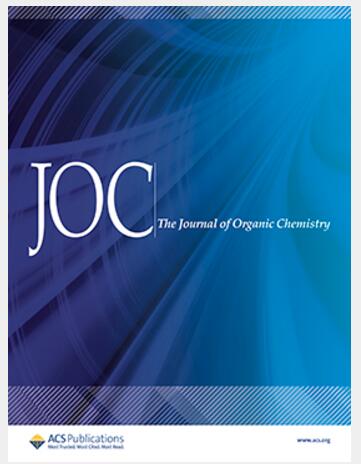Dearomative Difluoromethylation of N-Heterocycles and Pharmaceuticals with Bromo(difluoro)acetic Acid.
IF 3.6
2区 化学
Q1 CHEMISTRY, ORGANIC
引用次数: 0
Abstract
Given the significant prevalence of N-heterocycles in small-molecule pharmaceuticals, the selective N-difluoromethylation is of paramount importance in drug discovery and development. However, such integrated approaches remain underexplored, presumably due to the lack of efficient synthetic methods. In the present research, for the first time, we introduce a new and broadly applicable technique for the scalable difluoromethylation of N-heterocyclic substrates, including drugs using low-cost and commercially available bromo(difluoro)acetic acid in the presence of K2CO3 at room temperature to produce 45 desired complex Het-NCF2H products featuring an imine functional group, which were hitherto impossible to produce. Depending on the type of N-heterocycle, this advance also permits the inclusion of two CF2H units. Crucial to success is the nucleophilicity and less steric hindrance on the nitrogen atom of the heteroarene ring that enables N-difluoromethylative dearomatization of N-heterocycles. Overall, this unique transformation was transition metal-free, practical, scalable (>50 g), tolerant to diverse reactive functional groups with excellent chemoselectivity, and adaptable for difluoromethylation of commercial drug molecules. Ultimately, we have also unveiled a prominent synthetic application for rapid hydrodefluorinative reduction in a single step to access complex N-methylated Fsp3-enriched motif. This cost-effective strategy increases the synthetic access of N-difluoromethylated compounds.n -杂环和药物与溴(二氟)乙酸的脱芳二氟甲基化。
鉴于n -杂环在小分子药物中的普遍存在,选择性n -二氟甲基化在药物发现和开发中具有至关重要的意义。然而,这种综合方法仍未得到充分探索,大概是因为缺乏有效的综合方法。在本研究中,我们首次引入了一种新的、广泛适用的技术,用于n -杂环底物的可扩展二氟甲基化,包括在室温下使用低成本和市售的溴(二氟)乙酸在K2CO3存在下生产45种所需的具有亚胺官能团的络合物Het-NCF2H产品,这些产品迄今为止是不可能生产的。根据n -杂环的类型,这一进步也允许包含两个CF2H单元。成功的关键是亲核性和杂环上氮原子的空间位阻较小,使n -杂环的n -二氟甲基化脱芳化。总的来说,这种独特的转化是无过渡金属的,实用的,可扩展的(bbb50 g),对各种反应官能团具有良好的化学选择性,并且适用于商业药物分子的二氟甲基化。最后,我们还揭示了一个突出的合成应用,即一步快速氢脱氟还原,以获得复杂的n -甲基化fsp3富集基序。这种具有成本效益的策略增加了n -二氟甲基化化合物的合成途径。
本文章由计算机程序翻译,如有差异,请以英文原文为准。
求助全文
约1分钟内获得全文
求助全文
来源期刊

Journal of Organic Chemistry
化学-有机化学
CiteScore
6.20
自引率
11.10%
发文量
1467
审稿时长
2 months
期刊介绍:
Journal of Organic Chemistry welcomes original contributions of fundamental research in all branches of the theory and practice of organic chemistry. In selecting manuscripts for publication, the editors place emphasis on the quality and novelty of the work, as well as the breadth of interest to the organic chemistry community.
 求助内容:
求助内容: 应助结果提醒方式:
应助结果提醒方式:


